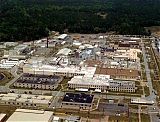|
|
|
|
|
|
|
|
|
|
|
Elza Gate (Melton Lake Industrial Park)
|

|


|

|
The Elza Gate Site, located in Melton Lake Industrial Park , Oak Ridge , Tennessee , was used by the Manhattan Engineer District to store high-grade uranium ore and ore processing residues in the early 1940s. The site was transferred to the U.S. Atomic Energy Commission in 1946 and was used as an equipment storage area for Oak Ridge National Laboratory. In the 1970s, the site was vacated and decontaminated, transferred to the City of Oak Ridge, and later sold to a private metal fabrication company.
In 1988, the property was surveyed for contamination and was transferred to FUSRAP. In 1991 and 1992, DOE remediated radioactive contamination on concrete pads and in soils and removed polychlorinated biphenyl and lead contamination. The site was released for unrestricted use in 1993.
No supplemental limits or institutional controls are in effect at the site, and DOE does not require on-site monitoring or surveillance. Legacy management activities consist of managing site records and responding to stakeholder inquiries.
1 files, last one added on Oct 30, 2005
Album viewed 442 times
|
|
|
|
|
|
|
|
|
|
|
|
|
|
|
|
|
|
|
|
|
|
|
|
|
Savannah River Site (SRS)
|

|


|

|
The Savannah River Site is a key Department of Energy (DOE) industrial complex dedicated to the National Nuclear Security Administration program, that supports the DOE national security and non-proliferation programs, and the EM program that addresses the reduction of risks through safe stabilization, treatment, and disposition of legacy nuclear materials, spent nuclear fuel, and waste.
The Savannah River Site encompasses over 300 square miles with more than 1,000 facilities concentrated within only 10 percent of the total land area. As cleanup activities are completed, operations will be concentrated to the site central core area. The land surrounding the central core area provides a protective buffer. All EM facilities and inactive waste units are being deactivated, decommissioned, and remediated. Facility decommissioning alternatives include demolition and in-situ disposal. However, if a viable reuse is identified, the DOE Savannah River Operations Office will remove a facility or group of facilities from the decommissioning scope.
The Savannah River Site is divided into 18 site areas, according to the types of mission activities that occurred at each. All waste types will be treated, stored and disposed. All nuclear material will be stabilized and safely stored. Groundwater contaminant plumes will be remediated to meet drinking water standards.
23 files, last one added on Apr 27, 2006
Album viewed 1852 times
|
|
|
|
|
|
|
|
|
|
|
|
|
|
|
|
|
|
|
